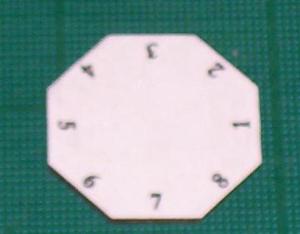Way back in May 2008, I wrote some SBS postings about how I created casualty markers. Even though a lot of people said kind things about my ideas and I was gratified to see several others adopt them for their own casualty markers, I still had a niggling level of dis-satisfaction with the outcome.
It turned out to be pretty simple to work out why I wasn’t happy: I didn’t feel I had the balance right between aesthetics and practicality. The base was just fine as a tool for the job, it just didn’t look very elegant with all those numbers visible around the edge. For more than a year, that’s been gnawing away quietly in the background without me ever hitting on the solution. It’s funny how you can look at something almost every day but not be able to see how to put it right.
Then, two nights ago, my sub-conscious woke me up in the early hours with the solution fully formed in my head. I jotted the eureka moment down in my notebook in case I forgot it again and patiently waited for the opportunity to iron out the wrinkles.
Here’s the basic idea…
Take one painted casualty figure and base it on a round base and paint and decorate the base just like you would for any normal base of figures. No numbers, round base – doesn’t sound like much an idea so far, does it? But here’s the bit that that makes the difference – use a shiny material like acrylic for the base or, if you use a wooden base, stick a circle of laminated card to the underside. What you end up with is a casualty figure on a round base with an underside that you can write on with a felt pen of a chinagraph pencil (can you still buy those?) but that is shiny enough to be wiped clean afterwards so it can be used over and over again.
Now you only ever need one casualty base per unit regardless of the size of the unit, the number of bases in the unit and the number of figures on each base. The same size of round base can be used for all your casualty markers – which gives a pleasing consistency. But that’s not all, using this method you can choose whether or not you remove bases from the table as the casualties mount for a unit. And finally, because the number of casualties is hidden from view, your opponent has to deal with a more realistic “fog of war” issue when assessing the strength of your units.
The next step is for me to produce a prototype that proves this idea works. I’ve already looked on the Litko website and the do indeed supply pre-cut circular acrylic bases. And, yes, I’ve checked, they do indeed still make chinagraph pencils (our Colonial Cousins call them “grease pencils).
Anybody else want to try out this idea so we can compare notes?
 RSS 2.0 feed
RSS 2.0 feed


 “For my games I use a collection of ‘dead and wounded’ figures mounted on 25mm square card as Casualty Markers. Half of the markers are numbered 1234 around the four sides, the other half 4567 around the sides. The marker is then placed next to a unit once it takes casualties, with the appropriate casualty marker number actually in physical contact with the unit. As casualties mount the marker is turned round to show the current casualty state. Once the casualties reach the number of figures on a base, a base is removed.”
“For my games I use a collection of ‘dead and wounded’ figures mounted on 25mm square card as Casualty Markers. Half of the markers are numbered 1234 around the four sides, the other half 4567 around the sides. The marker is then placed next to a unit once it takes casualties, with the appropriate casualty marker number actually in physical contact with the unit. As casualties mount the marker is turned round to show the current casualty state. Once the casualties reach the number of figures on a base, a base is removed.”
